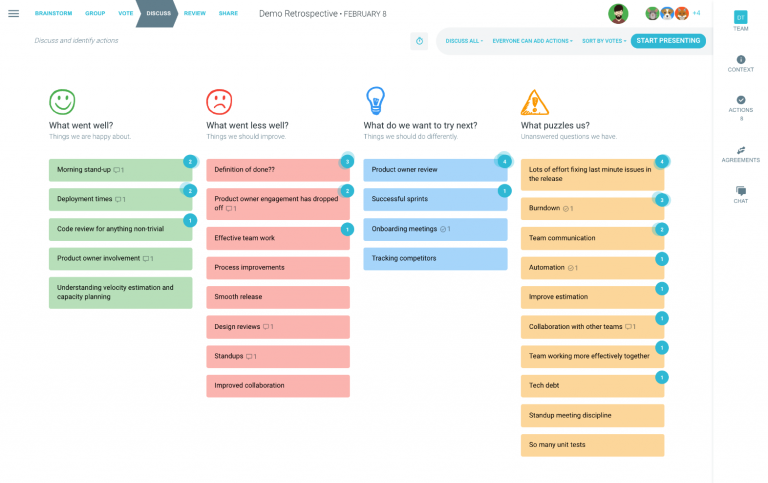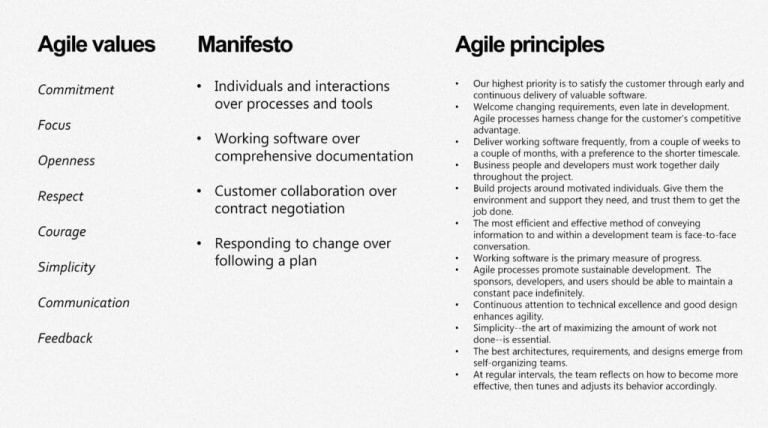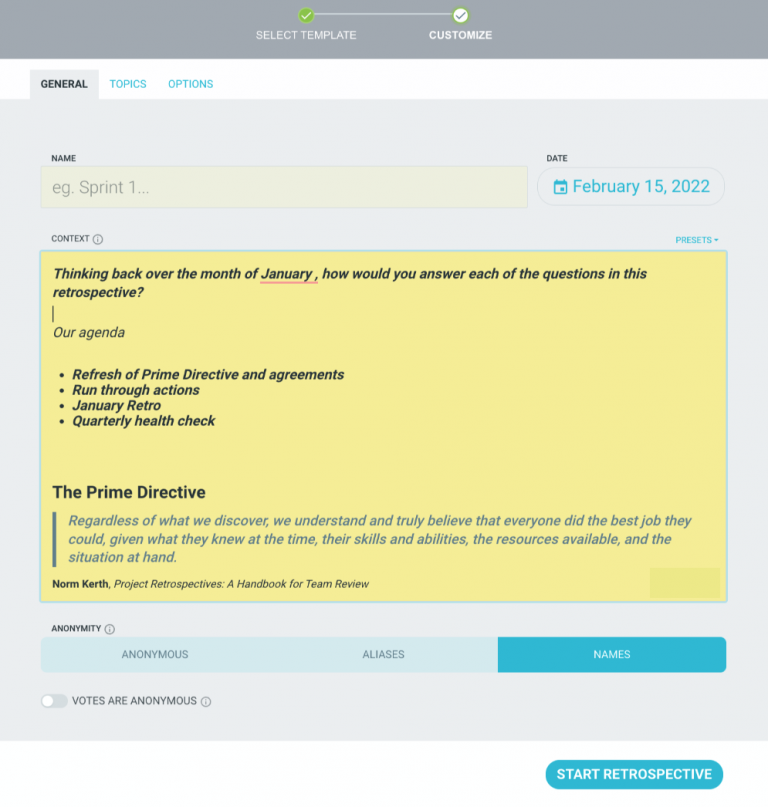Your Complete ScrumMaster’s Guide to Running Fun Easy and Effective Sprint Retrospectives
- Resources
What is a Sprint Retrospective?
What are the Basic Questions Asked in a Sprint Retrospective?
Who Joins the Sprint Retrospective Meeting?
How Long Does a Sprint Retrospective Meeting Run for?
Why are Retrospectives a Useful Agile Tool?
What is the Retrospective Prime Directive?
What is the Difference Between Remote, Online Retrospectives for Remote Teams and In-person Ones?
Why Remote Retrospectives are key to your Agile Process
How to Run the Best Online Retrospective with Remote Teams?
A Checklist For Running Your Agile Retrospective
What is a Sprint Retrospective?
A great team is one that continuously develops, learns, and grows.
The “retro” as it is commonly referred to is an all-hands team meeting held on a regular basis with the goal of improving the way things work going forward, based on what they have learned from the past. They are also called scrum retrospectives, agile retrospectives, or post mortems.
They are run in fixed time frames, say weekly, fortnightly, or monthly in which teams have completed a sprint (a set amount of work time).
Retrospectives allow teams to share what went well, and what didn’t. They can brainstorm new and improved ways of working for the upcoming sprint. This can either be by removing impediments, trying new ways of working, improving team morale, or engaging with stakeholders.

They are an important ceremony in Agile. It promotes continuous improvement and gives the team the opportunity to inspect and adapt on a regular basis. Your role as the Scrum Master as the servant leader is to help them do so effectively.
What are the Basic Questions Asked in a Sprint Retrospective?
The key areas for the team to explore are:
1. What went well?2. What didn’t go well?
3. What ideas do we have going forward?
4. How do we implement these actions?
5. Who should we acknowledge and what do we need?
However, there are many variations to this simple framework. The question set chosen by the Scrum Master can be based on a theme from a 1 on 1 discussion, team feedback, or a data source. This means that the questions are always not the same. In fact, it’s important to change the questions every so often to ensure that they are relevant and current to what is going on with the team and the organization at large.
Who Joins the Sprint Retrospective Meeting?
This is generally an all-hands meeting and can involve some or all of the following people
- The ScrumMaster
- The whole development or scrum team
- Any key stakeholder heavily involved in or impacted by the work of the team
- The Product Owner
- An Agile Coach
- An observer

How Long Does a Retrospective Meeting Run for?
This is usually based on the length of your sprint cycle. The meeting time for a 2-week sprint is usually 90 minutes, and up to a 3-hour meeting for a 1-month sprint. If it’s an iteration, it can be up to a whole day.
Why are Retrospectives a Useful Agile Tool?
At regular intervals, the team reflects on how to become more effective, then tunes and adjusts its behaviour accordingly.
– Agile Manifesto Principle
Agile requires a team to regularly inspect and adapt, reflect and improve, yet do so collaboratively and with purpose, supported by relevant goals. Retrospectives are a critical tool for scrum masters, development teams, and product owners to work collaboratively in a focussed and time-boxed way.
The main purpose of the retrospective is for the team to share what might be slowing things down and what changes can be made to improve outcomes. It means:
- Teams have a way to suggest improvements
- Challenges and issues can be addressed anonymously if need be
- Team morale and engagement can be improved
- Impediments can be identified and addressed early to increase velocity
- Mistakes and lessons learned and shared to avoid them being repeated
The caveat is that the retro is run with intention, and focus and that it is engaging as well as being time efficient.
On the other hand, if you never run a retrospective this could result in:
- Issues not being identified and discussed early
- Tension and anxiety build up which kills productivity and morale
- No opportunity to suggest new ideas and improve things as a team
- A top-down approach that does not empower the team
- A scrum master does not know what is motivating or demotivating the team
Bain & Company studied the time budget of 17 large corporations. It showed that up to 15% of a team’s time is spent in meetings, yet up to 71% of people in the actual meeting are dis-engaged, distracted, multi-tasking, or checked out.
Often cited causes are the lack of agenda, time budget, purpose, and decision process which drastically reduces the return on time invested.
Retrospectives offer a defined purpose, clear repeatable process, facilitated group decision making, and actions that can be created and tracked. Holding them on regular basis further increases accountability and discipline.
Timeboxing the retrospective provides momentum, and having the right template means people have a structure for providing thoughts easily.
With online tools, like TeamRetro, you can make the retro semi or fully anonymous increasing psychological safety. Everyone has an equal opportunity to participate in the discussions and decision-making process allowing you to identify where there is resistance or energy and therefore increase buy-in. By giving the team a role in the process, they are more likely to support any changes in the next iteration.
They are also a forum for Agile Values, the Manifesto, and Principles to be demonstrated practiced, and applied.

PRO TIP: Remind your team every so often of the purpose and value of a retrospective to help keep it at the top of mind, and re-engage them to participate in the process.
What is the Retrospective Prime Directive?
“Regardless of what we discover, we understand and truly believe that everyone did the best job they could, given what they knew at the time, their skills and abilities, the resources available, and the situation at hand.”
-Norm Kerth, Project Retrospectives: A Handbook for Team Review
This mindset aims to create a culture and communication style at the meeting. Rather than judgment, blame, and shaming, the retrospective prime directive seeks to create a collaborative way of thinking. Each person in the team shows respect, understanding, and curiosity in order to learn and grow together.
This is just one of the reasons why we have this as the default text in the Context and Agenda of your retrospective meetings. As a new team, it’s important to run through this as a starting point – or create one based on your team dynamics.
Essentially, creating a prime directive for your own team helps everyone behave and act in an agreed and productive way at your meeting.

A reminder at the start of the retrospective via the agenda can help set the tone for the rest of the session.
What is the Difference Between Remote, Online Retrospectives for Remote Teams and In-person Ones?
Even if a remote or online retro means that not everyone is physically in the same room, the goals and principles of Agile do not change. Agile is about the process.
An in-person retrospective means you have to book a room, set it up, draw things on boards, check the logistics and collate sticky notes afterward. For remote retros, the focus is more on having the right video conferencing tool (Zoom, MS Teams, Skype) and having an online retrospective tool to collaborate effectively. It’s not just a stream of chats, unorganized sticky notes, or someone trying to scribe what is said and not being able to join in themselves.
According to this 3,500 large State of Remote Work report, working from home is on the rise with the benefits of flexibility, no commute time and family time being some key benefits. On the other hand, collaboration, communication and loneliness represent 40% of the biggest challenges. Retrospectives are then both an opportunity and a challenge. It is a time that people can come together and an opportunity to share and learn from each other in a supportive environment. The pros and cons of remote online retrospectives are:
The pros
- Easier for people to meet
- Ability to have asynchronous retrospectives
- Real-time feedback
- No manual collation
- Equal opportunity for people to contribute
- Independent brainstorming and voting
- Anonymous options
- More time for discussion and team ponding
- No more production blocks or anchoring ( 1 person talking about their idea)
- No room set up
The cons
- A loss of all body language ques
- A potential loss in a general sense of togetherness
- Reliance on technology for video conferencing and collaboration tools
- Facilitating a remote retrospective is more challenging.
It’s important with online retrospectives to find ways to build reports and ensure that every voice in the room is “heard”. You may not have to prep a room, but you still need to prep for the session.
The need to continue to build engagement, connection, participation, and buy into decisions applies to both types of retrospectives, albeit with slightly different strategies.
Whilst online meetings don’t have everyone standing side by side, this doesn’t mean it has to be impersonal or cold. It can lend itself to understanding a bit more about each person in the team, to find out more about them, and for them to share a little of their lives with everyone. Having activities for online meetings that connect, energize, challenge, or engage the team including your retrospective ensures that there is the opportunity to build these relationships.
Why are Remote Retrospectives Key to the Agile Process?
Being remote means that your retrospectives become even more vital as an agile ceremony. This is a time for the team to come together to share learnings, celebrate, and decide on what is happening next. The connection that may have been lost in face-to-face meetings is rebuilt through this connection.
Even if you have some of the team in the same room, being able to incorporate everyone in the team wherever they may be, opens up the possibility of more diverse ideas, creating a sense of team, and start building relationships that can’t form on a day to day basis in a traditional office environment. Using videos during a remote retrospective can you a glimpse into the personality and lives of your teammates.
It can also help maintain accountability in the team whilst working from home. Being able to come up with action items at your remote retrospective and people seeing the impact can boost team morale and create more energy for the next retrospective.
How to Run the Best Online Retrospective with Remote Teams?
Here are 5 of our own learnings and reflections when we ran our own retros with our remote teams.
- Allow time to say hello and goodbyeEven just a few minutes is important and is ideal for asking people to sign in a little early or on time. It could start with an icebreaker, but a simple question of how everyone is, or giving a number out of 10 engages everyone early on in the piece. Likewise, it’s too easy to press a button that shuts everyone off so allow for people to say goodbye at the end of the meeting.
- Set the etiquette for your remote meetingsThis could mean turning on cameras, use of backgrounds, typing in chat for check-in or how people actually engage in the meeting that day. Online etiquette is real. Check out this clip – if video meetings happen in a face-to-face environment and you’ll immediately see why things like background noise, how to leave the meeting, and how to ask questions and make comments suddenly become very real issues.
- Use comments and real-time feedback mechanismsJust one of the advantages of going digital means that people can brainstorm individually without distraction, vote for ideas independently without bias, and be able to add additional comments to people’s ideas that could be worth their weight in gold. Rather than being hindered by production blocks, asking people to write down what they think as comments can enrich the topic.
- Sort out the logistics Just like you would check the room for your in-person retro to ensure it wasn’t double-booked, that the heat or cooling was on, and that you had the right tools to do the job, the same goes for a quick tech check with your remote retro. Get the tools up and running, links ready to go, and have a tech buddy or colleague support this process and you will be able to focus more on the conversation than the technology when the time comes. If you are working with timezones, this can be tricky negotiating a day and time that works with most people and it might mean having to alternate times for fairness or to consider asynchronous retrospectives.
5. Don’t forget the basic elements of agile retrospectives A remote retrospective does not mean that the fundamentals of an agile retrospective are cast aside. Ensuring accountability, a focus on culture and continuous improvement, follow up and follow through and that people are focused on the retrospective and not trying to solve problems in the same meeting all continue to apply.
A Checklist for Running your Agile Retrospective
Whether your team is in-person, remote, distributed, or a hybrid, here’s a checklist of everything you need to consider to run the “perfect” retrospective. After all, if you factor the time and costs into the number of people in the meeting, you certainly want to make sure that everyone is getting value out of the meeting.
What does the “perfect” retro look and feel like?
If you ask an agile team the perfect retro is one where the team walks away feeling
- Engaged – in the process and outcomes
- Empowered – to be able to take steps to improve
- Energised – and looking forward to the next sprint
The team has had a chance to properly reflect on their experience, had the opportunity and support to put their thoughts forward honest and without judgment, and brainstormed solutions in a supportive environment.
Bad hygiene factors, however, are numerous and can thwart the perfect retro. From lack of focus and timekeeping, through to indifference and repetition, all add scars onto what would be the perfect face of an agile ceremony. Instead, the experience for the team is ineffective, rushed, tedious, and a waste of time.